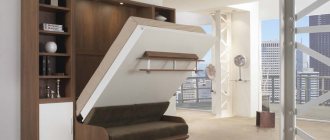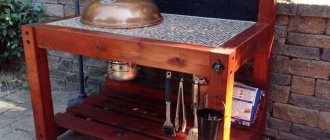DIY hammock stand
A hammock installed in the right place and in the right position guarantees a great rest. You can hang a hammock between two trees on a shady lawn, between rafters, on a porch—even in a bedroom, using straps, wall hooks, a hammock stand , or a combination of methods.
The best way is to make a hammock stand with your own hands , then you will not have problems with adjustment. At first glance, this may seem like a difficult task, but after reading the article, make sure that assembling such a structure is not a problem at all. If you have a drawing and step-by-step photographs, making a hammock stand is simple and inexpensive.
Most popular types
Manufacturers are constantly working to create new types of hammocks. Everyone wants to make their product better, more convenient and comfortable, thereby attracting more consumers.
Today, the most popular among summer residents are three types of hammocks:
- Hanging
is a traditional type of hammock that everyone is used to. The main feature is practicality and reliability. They are easy to transport from place to place and can be quickly installed. It is enough to find two trees standing at the required distance from each other and hang the hammock, firmly securing it with tension parts. Instead of trees, you can also use poles. - Frame
hammocks are also popular among summer residents. They have different shapes and all sizes. The main feature and distinctive feature is that they can be placed absolutely anywhere. To install a frame hammock, you don’t need to look for two trees or poles; it can be placed both at home and outdoors. They are prefabricated and stationary. The latter are especially durable, but you can’t take them with you fishing or barbecuing. - Non-standard types
of hammocks differ in their shape and cost.
A frame hammock is chosen by lovers of reliability and comfort
The most popular non-standard ones are:
- a hammock chair, where it is convenient to drink a cup of aromatic tea or work on a laptop;
- hammocks-swings, which are loved by little summer residents, and adults too;
- a hammock with a canopy that will protect from both the sun and rain, etc.
A good option is a children's hammock, covered with a mosquito net and a sun canopy. While the kids sleep in the fresh air, parents can safely work on the site. The child is under the supervision of adults and is safe.
Pictured is a hammock chair
Hammock swing
Material selection
Wood and metal have their pros and cons. Their features do not have a significant impact on the technical characteristics of the design. Frames made from them are constructed according to the same principle.
Solid beams and boards
The main advantage of wood is its decorative effect. The fibers create a beautiful pattern on the cut. It is clearly visible even through a layer of paint. The strength of such a base is not inferior to a metal profile. Hardwoods have the greatest strength. Oak supports will last more than a hundred years. Spruce and pine are most often used. They are less reliable, but their safety margin is enough to withstand the weight of a person.
Pixabay
The main disadvantage is that the fibers are afraid of moisture. Wooden parts must be dried and treated with protective compounds before assembly, even if they meet technical standards. This process takes several days.
Steel and wrought iron
Metal products are more reliable than wooden ones. They do not experience temperature and humidity deformations.
As a rule, steel products are used to create the frame. It is better to use profile pipes - it is easy to get injured on the corners and profiles with a rectangular cross-section. When exposed to moisture, steel quickly rusts. Effective protection is provided only by galvanizing and copper plating of the surface. The primer and paint coating retard corrosion only temporarily. Pre-treatment takes only a few hours. A primer is applied to the cleaned surface, allowed to dry, and then painted with a brush, roller or spray.
Wrought iron does not need a protective coating. It is more durable than steel pipes and is not subject to corrosion. Prefabricated elements and their decor must be ordered from a craftsman. You can make your own sketches and prepare drawings with dimensions.
Pixabay
We make it ourselves – easily and economically!
The hammock is quite exotic for the domestic summer resident, who, even recognizing the beneficial properties of the latter, is in no hurry to purchase it, since he considers this pleasure too expensive and troublesome to install.
Specialized stores offer quite a lot of ready-made solutions for every taste and budget, but there is an easier way to increase the comfort of relaxation at the dacha - make a hammock for the dacha with your own hands.
This is quite simple to do, and the cost of materials will be minimal.
Choosing a place
The choice of place to install a hammock should be taken very seriously. After all, its correct functionality will depend on this.
The selected area should not be in a drafty area, so as not to get sick after a well-spent weekend.
It also needs to be protected from direct sunlight and places where water accumulates after rain.
As a rule, hammocks in the country are hung between two trees, choosing the most shady place on the territory. This arrangement of the bed brings a person closer to nature and gives him the opportunity to have a good rest.
Also, at the dacha, you can hang a hammock on pergolas or wooden canopies. The main thing is that their design is strong enough
. In this case, you get shade from the sun, a roof over your head during rain, and the pleasure of a pleasant pastime - all in one.
Have you bought a hammock? How to properly hang a hammock at the dacha, watch our video:
More instructions:
DIY hammock stand option 2
The second option will require approximately the same belongings and materials from you. The same timber, the same studs, is it really possible that the overall design of the hammock will be somewhat different? Also take a look at the drawing... All dimensions can be taken from it. We also craft the parts and fasten them together. Fundamentally, the only difference is a different design, that's all. This is how the main parts are fastened together...
The finished hammock can also be covered with stain and varnish. There is a leg on one jib to make it easier to lie down in the hammock.
DIY hammock stand option 1
So, the first option will require wooden blocks, pins, nuts, washers, a grinder, a hacksaw or circular saw, stain, a drill, hooks and your skillful hands. Take a look at the drawing, it will be the starting point. Actually, all the dimensions for the bars can be seen in the drawing. The section of the bar is 80*80. You will also need a board, 100*30. Now we proceed directly to the manufacture of the stand. We measure, cut, drill, assemble, twist. The final operations will be sanding, it’s good if you have a machine for this, and painting with stain and varnish.
All that’s left now is to pull up a hammock and enjoy relaxing in the lap of nature.
Metal beds
Another craftsman from our portal, henc, chose metal as the material for his frame, since it is clearly “friendly” with welding. He used a pipe with a cross-section of 60×40 mm, resulting in a hammock design on a stand with the following parameters:
- The base is 2 meters.
- Hammock stands – 1.8 meters (angle about 60⁰).
- Transverse supports – 1.5 meters each.
- Jib beams.
- Hooks.
- Chain.
The resulting mobile hammock on a stand was well appreciated by this family.
hencFORUMHOUSE Member
The kids started a “fight” for a place on the hammock; by the evening they only calmed down, but they were busy and in full view.
Rol248 made a frame from scraps.
Rol248 Member FORUMHOUSE
This is what I got from scraps of old pipes and corners. Since hammocks gradually stretch and sag, we had to come up with a system for extending the posts.
henc solved this problem by attaching the hammock to a chain - as it sagged, he simply shortened the links.











